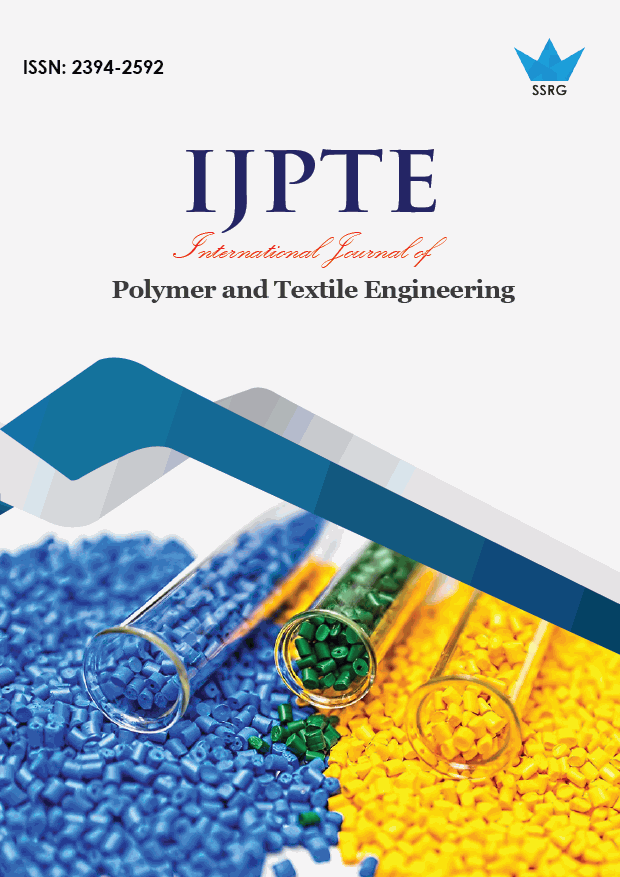Comparative Analysis of Fabrics Made from Eli-Twist and Other Doubled Yarns

| International Journal of Polymer and Textile Engineering |
| © 2020 by SSRG - IJPTE Journal |
| Volume 7 Issue 2 |
| Year of Publication : 2020 |
| Authors : Saatish Lavate, Aadhar Mandot, P.V. Kadole |
How to Cite?
Saatish Lavate, Aadhar Mandot, P.V. Kadole, "Comparative Analysis of Fabrics Made from Eli-Twist and Other Doubled Yarns," SSRG International Journal of Polymer and Textile Engineering, vol. 7, no. 2, pp. 14-17, 2020. Crossref, https://doi.org/10.14445/23942592/IJPTE-V7I2P103
Abstract:
In today’s competitive world, dimensioned product quality at competitive price is of utmost importance and weavers are not an exception from this. The yarn quality plays a crucial role in fabric forming departments of new high speed weaving technologies in terms of machine performance and fabric quality. The conventional spinning technology delivers the yarn with higher irregularity and more hairiness resulting in loss of productivity and deterioration in quality in subsequent processes. Many modifications have taken place in Ring spinning technology such as condensed spinning, value adding attachments and EliTwist
EliTwist produces a two-ply yarn with identical direction of twist in both yarn legs as well as the final yarn. It has all the advantages of condensed spinning and yarn doubling during spinning and weaving. But, the acceptance in the spinning industry is not in proportion to the advantages offered by this technology.
In the present study, fabric samples were produced by using double yarns manufactured by three different methods like viz: (i) combed compact double yarn, (ii) regular combed doubled yarn and (iii) EliTwist yarns. The yarn and fabric properties of samples made by these three technologies are compared. The EliTwist yarn shows better characteristics compared to the fabrics made by combed compact doubled and combed doubled yarns.
Keywords:
Doubled Yarns, Fabrics Made, Eli-Twist
References:
[1] https://www. suessen. com / fileadmin / suessen / products /EN/ ring- spinning / elitecompactset-v5/brochures-
[2] Stalder H. and Rusch A. (2002), ‘Successful compact spinning process’, Intl.Textile Bulletin., Vol.48, No.1, pp.42-43.
[3] Product leaflets from https://www.suessen.com:
https://www.suessen.com/fileadmin/suessen/products/EN/ring-spinning/elitecompactset-v5/brochures-leaflets/EliTe_CompactSet_V5_slp.0100NE_06.12.pdf
[4] Product Leaflets from https://www.suessen.com
[5] Binternagel T. (2000), ‘New potential in downstream
processing of COM 4 yarns’, Meliand Textilber., Vol.80, pp.702-707 (E34-E35).
[6] Scheibe H. and Knecht R. (2001), ‘Requirement of compact yarn on the winding process’, Meliand Textilber., Vol.81, No.4, pp.237-240 (E58- E60).
[7] Behera B.K. Hari P.K. and Ghosh S. (2003), ‘Weavability of compact yarn’, Meliand International., Vol.9, pp.311-314.
[8] Dr.D.Mathiyalagan, “Anti Microbial Fabrics Manufacturing using the BenzalKonium Chloride in Antimicrobial Fabric Finishing”, SSRG International Journal of Pharmacy and Biomedical Engineering, Vol-1,Iss-1,2014.
[9] Subramanian S.N, “An Investigation of the Structure and Properties of Jet Ring Spun and Other Types of Compact Yarns, PhD thesis”, Faculty of Technology, Anna University: Chennai, November 2005.
[10] Textile Bulletin. Vol.48, No.1, pp.42-43.
[11] Artzt P. (2003), ‘The effect of different spinning processes on yarns’, ITB, Vol.49, pp.40-43.
[12] Furter R. (2003), ‘Experience with quality management of
compact yarns’, Meliand Intl., Vol.9, No.1, pp.20-22.
[13] Textile Res., Vol.27, No.12, pp.362-368.
[14] Kanthimathinathan A. (2005), ‘Compact spinning process: A Bird’s eye view on the systems and benefits in post-spinning process’, Proc. of National Conf., IYQM, BIT, Sathyamangalam. India.
[15] Sudhakar P. and Gobi N. ‘Analysis of comfort and low stress mechanical properties of ring and compact yarn knitted fabrics’, Proc. of National Conf., IYQM, BIT, Sathyamangalam, India 2005.
[16] Ozdil N., et.al. ‘A comparative study of the characteristics of compact yarn-based knitted fabrics’, Fibers & Textiles in Eastern Europe, Vol.13, No.2 (50), pp.39-43, 2005.

 10.14445/23942592/IJPTE-V7I2P103
10.14445/23942592/IJPTE-V7I2P103